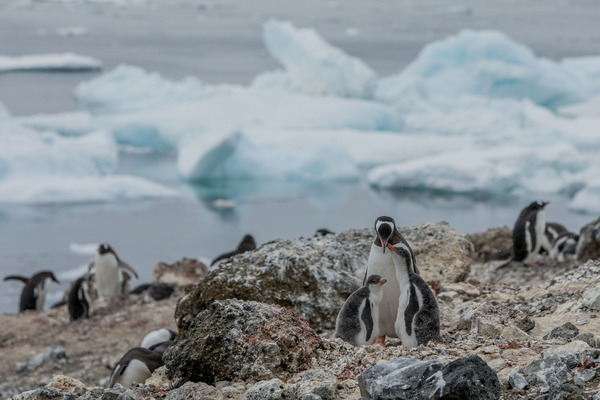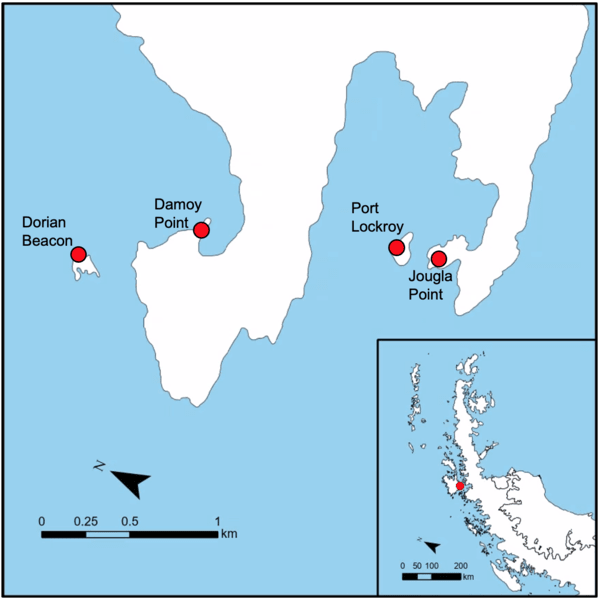LINKED PAPER Penguins in the anthropause: COVID-19 closures drive gentoo penguin movement among breeding colonies. Flynn, C. M., Hart, T., Clucas, G. V., Lynch, H. J. 2023. Biological Conservation. DOI: 10.1016/j.biocon.2023.110318. VIEW
Imagine you wake up on a cruise ship in Antarctica to the sound of your expedition leader over the intercom announcing that today is a big day – you get to visit Port Lockroy, a post office in the middle of a gentoo penguin colony! Because your ship holds hundreds of passengers, but only 60 are allowed ashore Port Lockroy at a time, you get to take a zodiac cruise around the harbor before your turn on the island. You see rafts of penguins swimming in the water, watch your fellow passengers and some post office staff walk around the island, and get a look at the other Pentoo Penguin and Antarctic Shag colony in the harbor, Jougla Point. Finally, it’s your turn on the island. You land and are immediately immersed in the racket and barnyard odor of the penguin colony, then walk up a designated path to the main building. As you scrub the guano off your boots and walk into the post office, you snap a picture of the gentoo nests just 1 meter away from the front door. You buy a penguin keychain and send a postcard to your family, then are ushered out of the base so the other passengers can enter. You are allowed to wander around the island to look at the penguins and other buildings on the island, as long as you don’t walk past the roped off section protecting the penguins nesting at the far end of the island. Too soon, you are ushered back to the zodiac to bring you back to the ship. Once everyone on your ship has gotten the chance to send their postcards, your ship departs to your next destination, and you get a glimpse of the next cruise ship pulling into the harbor to go through the same process in the afternoon.

Figure 1. Gentoo penguins © Tomás Munita.
But what happened at Port Lockroy when the post office closed in the 2020-21 and 2021-22 austral summers because of the COVID-19 pandemic? Well, the staff left the island, far fewer visitors landed, and the Gentoo Penguin population size nearly doubled. It increased from 535 nesting pairs in 2018 to 978 nesting pairs in 2021. In a shockingly quick reversal, the number of nesting pairs then fell to 529 in 2022, the year the post office reopened. The message is clear- more gentoos breed at Port Lockroy when there are no humans around than when the post office is open. At Jougla Point, the larger neighboring site just 150 meters away, the population also nearly doubled, adding 903 pairs from 2019 to 2021, then decreased by 1,093 pairs from 2021 to 2022. So whatever pressure was affecting the Port Lockroy population size in non-pandemic years, be it the presence of people, zodiacs, or large cruise ships, was affecting Jougla Point as well.

Figure 2. A map of the gentoo penguin colonies in the Port Lockroy area (data from the SCAR Antarctic Digital Database, 2023).
But where did this large influx of nesting penguins come from? Gentoo Penguins do not return to their colonies to nest until they are at least two years old, so these population increases cannot be the result of baby booms during the pandemic. The answer to this question seems to lay just outside the Port Lockroy harbor, at the two gentoo colonies Damoy Point and Dorian Beacon. Both sites showed the opposite pattern than Port Lockroy and Jougla Point; they lost a combined 1,001 nesting pairs from 2018 to 2021, then gained 752 nesting pairs from 2021 to 2022. While these sites do receive tourism in non-pandemic years, they do not host as many visitors as the Port Lockroy harbor. When looking at these four colonies together, it seems that over 1,000 gentoo pairs that would have nested outside of the Port Lockroy harbor in pre-pandemic conditions instead chose to nest at Port Lockroy and Jougla Point when the post office shut down, then left the harbor when tourism resumed full force in 2022. (All census counts reported in this post come from a combination of Che-Castaldo et al. (2023), Dunn & Nichol (2023), and the study this blog post is based on, Flynn et al. (2023).)

Figure 3. The number of gentoo penguin nests at Port Lockroy over its survey history, with the reported observer error shown by the error bars, and the years the post office was closed highlighted in pink.
These results show a surprising amount of flexibility in Gentoo Penguin nesting site selection. Though none of these penguins are banded so we cannot track individuals’ movements, it seems that gentoos were being dissuaded from nesting in the Port Lockroy harbor when roughly 15,000 passengers landed annually (IAATO 2023) and staff inhabited the island prior to the pandemic, but when those pressures were removed, gentoos immigrated from different breeding colonies to nest at Port Lockroy and Jougla Point. This is likely because the traffic to Port Lockroy and Jougla Point compounded and negatively affected both sites inside the harbor. These negative pressures may include how closely people walk to nesting penguins (Cajiao et al. 2022), how closely people walk to penguin trails that they use to walk across the colony (Dunn et al. 2019), water or noise pollution from zodiacs and ships, and physical barriers created by zodiacs and ships. Future studies should attempt to pinpoint which of these anthropogenic effects are dissuading gentoos from nesting at these popular sites.
While the number of gentoo penguins has been increasing on the Antarctic Peninsula, so pairs avoiding nesting in the Port Lockroy harbor will not hurt the species’ overall well-being, understanding human impacts on Antarctica is imperative. With the exception of the pandemic years, visitation to Antarctica has been rapidly increasing in the 21st century (IAATO 2023). We need to know how much disturbance is too much for Antarctica’s wildlife so we can minimize our impacts on the most remote continent in the world.
References
Cajiao, D., Leung, Y.-F., Tejedo, P., Barbosa, A., Reck, G., Benayas, J. 2022. Behavioural responses of two penguin species to human presence at Barrientos Island, a popular tourist site in the Antarctic Peninsula region. Antarctic Science 34:2. VIEW
Che-Castaldo, C., Humphries, G., Lynch, H. 2023. Antarctic penguin biogeography project: database of abundance and distribution for the Adélie, chinstrap, gentoo, emperor, macaroni and king penguin south of 60 S. Biodiversity Data Journal 11. VIEW
Dunn, M.J., Forcada, J., Jackson, J.A., Waluda, C.M., Nichol, C., Trathan, P.N. 2019. A long-term study of gentoo penguin (Pygoscelis papua) population trends at a major Antarctic tourist site, Goudier Island, Port Lockroy. Biodiversity Conservation 28:1. VIEW
Dunn, M., Nichol, C. 2023. Population numbers and breeding success of Gentoo penguins (Pygoscelis papua) at Port Lockroy, Goudier Island, 2020–2023.
IAATO. 2023. Visitor statistics download. Retrieved July 25, 2023.


